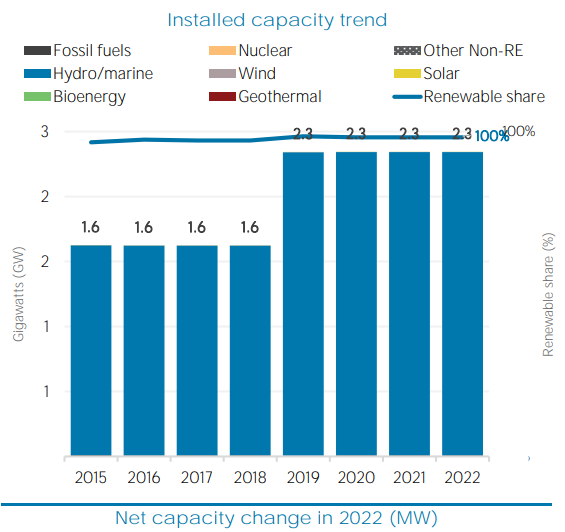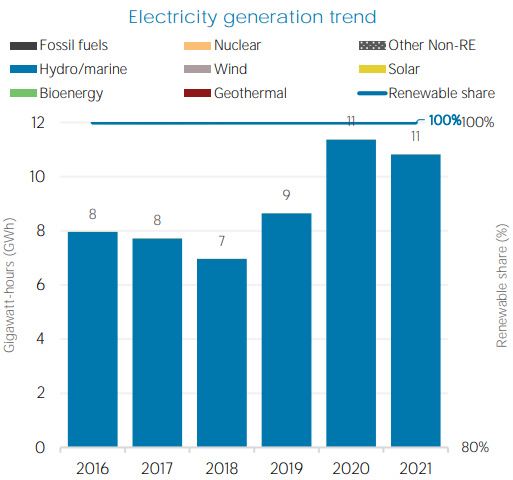Bhutan has witnessed significant economic growth, averaging 7.5% annually since the 1980s. This growth is attributed to public sector investment in the crucial hydropower sector, as well as strong performance in the service industry, particularly tourism.
This growth has led to substantial poverty reduction. Extreme poverty (based on the $2.15/day benchmark) has been eliminated as of 2022.The population living below the $6.85/day poverty line has significantly decreased from 39.5% to 8.5% between 2017 and 20221
Although Bhutan’s GDP is relatively low at $2.653 billion (178th globally), it's crucial to consider:

Fig 1: Installed capacity trend in Ethiopia ( IRENA 2022 )
Bhutan stands out as a global leader in harnessing renewable energy. Its primary source of energy is hydropower, accounting for nearly 100% of its electricity generation [1] . This reliance on hydropower contributes significantly to Bhutan's economic development, environmental sustainability, and commitment to renewable energy.
Benefits of Hydropower:

Fig 2: Electricity Generation trend in Ethiopia ( IRENA 2022 )
In 2021, Bhutan exported $35.2k in Hydrogen, making it the 121st largest exporter of Hydrogen in the world. At the same year, Hydrogen was the 67th most exported product in Bhutan. The main destination of Hydrogen exports from Bhutan are: India ($35.2k).The fastest growing export markets for Hydrogen of Bhutan between 2020 and 2021 were India ($25.1k). [2]
In 2021, Bhutan imported $66.3k in Hydrogen, becoming the 185th largest importer of Hydrogen in the world. At the same year, Hydrogen was the 519th most imported product in Bhutan. Bhutan imports Hydrogen primarily from: India ($66.3k).
Bhutan, a nation synonymous with sustainability and Gross National Happiness (GNH), is exploring a new frontier: green hydrogen. While a dedicated hydrogen policy framework remains under development (as of February 2024), Bhutan's initiatives suggest a proactive approach towards embracing this clean energy source.
Embracing Green Hydrogen:
Bhutan's focus leans towards green hydrogen, produced through electrolysis using renewable energy, aligning with their commitment to sustainability and carbon neutrality. The Bhutan Green Hydrogen Roadmap (2023) [3] lays out a strategic framework for building a green hydrogen economy. This roadmap aims to:
Hydrogen Policy Framework
The launch of the Green Hydrogen Roadmap signifies Bhutan's commitment to building a regulatory framework that supports their sustainability goals. Collaborations with entities like the United States Energy Association demonstrate their efforts in exploring best practices and developing a sound framework.
Developing a comprehensive hydrogen policy framework necessitates addressing crucial aspects:
• Safety regulations governing production, storage, and utilization.
• Origin guarantees ensuring the green credentials of the hydrogen used.
• Market facilitation through incentives and streamlined permitting processes.
While Bhutan's hydrogen policy is nascent, the country's proactive measures – the Green Hydrogen Roadmap and international collaborations – reveal a clear intention to explore green hydrogen for energy diversification and enhanced sustainability. Observing how Bhutan's hydrogen policy evolves in the coming years, contributing to its unique approach to development and environmental responsibility, will be fascinating.
Bhutan, a champion of sustainability and carbon neutrality, is exploring the potential of green hydrogen for its energy future. However, a specific and established hydrogen regulatory framework is still in its development stage (as of February 2024).
Current Landscape:
Expected Outcomes:
The Green Hydrogen Roadmap is expected to pave the way for the establishment of a comprehensive hydrogen regulatory framework, encompassing:
Overall, while a defined hydrogen regulatory framework in Bhutan remains in its early stages, the country's proactive approach through the Green Hydrogen Roadmap demonstrates their commitment to exploring this clean energy source for a sustainable future. It will be interesting to witness how Bhutan's policy framework evolves in the coming years, contributing to their unique approach to development and environmental responsibility.

Challenges and Opportunities:
Developing infrastructure is crucial for harnessing its abundant renewable energy potential. This includes:
Balancing development and environmental protection: While infrastructure development is crucial, it's essential to ensure it happens in a sustainable manner, minimizing environmental impact.
Bhutan faces both challenges and opportunities in its pursuit of sustainable development. By strategically developing its infrastructure while harnessing its renewable energy potential, the country can achieve its ambitious goals of economic growth, energy security, and environmental responsibility.
N/A
While Bhutan holds immense potential for green hydrogen development, as of February 2024, no specific investment announcements for green hydrogen projects have been officially made. However, several initiatives indicate their strong interest and ongoing exploration:
While specific investment announcements in Bhutan's green hydrogen sector are still awaited, the country's proactive approach through the Green Hydrogen Roadmap, international collaborations, and its inherent renewable energy potential position it as a promising player in the future of green hydrogen development.